In the ever-evolving landscape of IT Service Management (ITSM), the choice between EasyVista vs. Jira Service Management has become a critical decision for organizations seeking to optimize service delivery, improve operational efficiency and increase customer satisfaction. With a variety of ITSM solutions promising to meet different needs, navigating this complex terrain can be a daunting task.
In this blog post, we’ll embark on a head-to-head ITSM tools comparison of these two prominent contenders.
However, the ITSM journey doesn't end with these two options alone. Each organization has distinct demands and aspirations when it comes to Service Management. That's why we'll introduce you to an alternative platform that could be the perfect match for your unique needs: InvGate Service Management. This robust service desk software is meticulously designed to streamline service delivery, empower organizations, and elevate their ITSM practices to unprecedented heights.
Continue reading and discover which platform could be your key to Service Management success!
Table of contents
- TL;DR
- What is EasyVista?
- What is Jira Service Management?
- Considering InvGate Service Management as an ITSM solution alternative
TL;DR
- EasyVista stands out for its user-friendly interface and robust workflow editor. However, some criticisms arise concerning inconsistent vendor support and the platform's complexity leading to time-consuming actions.
- Jira Service Management garners acclaim for its intuitive interface that facilitates Incident and Request Management, but users have highlighted challenges with its migration process complexities and limited native integrations requiring custom solutions.
- In contrast, InvGate Service Management stands out for its robust ticketing system, user adaptability, streamlined operations, no-code/low-code options, and ITIL4 certification, emphasizing its dedication to top-tier ITSM solutions.
We tried to be as thorough as possible, but if you don't have enough time to read it through and through, here's (another) TL;DR: InvGate Service Management can do everything we say here, and you can test it right away for free for 30 days.
Most looked-at features by buyers
When evaluating ITSM solutions, potential buyers typically focus on specific features that meet their organization's needs. These desired functionalities are crucial in guiding their decision-making process.
Let's explore the key aspects prospective purchasers commonly consider when comparing ITSM tools.
- Ticket Management System - Buyers place great importance on having a comprehensive Ticket Management System within their help desk software. This feature enables effective tracking, assignment, and resolution of customer inquiries and support requests.
- User-friendly experience and interface - Prospective buyers consider the user experience and interface of the platform. They look at how user-friendly it is and how it contributes to user adoption and productivity. An intuitive interface that enables efficient interaction with the software is highly valued. Additionally, organizations with remote or mobile workforces find mobile accessibility to be an important factor.
- Streamlined IT service catalog - Organizations often require a service catalog that allows users to request specific IT services or resources. This feature simplifies service requests, provides visibility into available services, and facilitates effective service delivery management.
- Support automation and Workflow Management - Buyers actively seek software solutions that offer automation capabilities to streamline routine tasks such as ticket routing, approvals, and escalations. These automation features enhance efficiency and productivity.
- Self-service portal and knowledge base - The inclusion of a self-service portal is highly valued by buyers, as it empowers end-users to independently resolve common issues and access relevant information without requiring direct assistance.
- Customization and flexibility - Buyers appreciate software solutions offering customization options, allowing them to tailor the platform to their business needs. This flexibility ensures the software aligns with their unique workflows and processes, ultimately enhancing user satisfaction and overall effectiveness.
- Seamless integration capabilities - Integration with other systems and applications is a critical requirement for buyers, as it ensures smooth data flow and process automation. Integrating with existing tools and platforms is highly valued for improved efficiency and a unified user experience.
- Pricing and support - Buyers assess the solution's cost-effectiveness, taking into account licensing models, subscription plans, and any additional costs related to features or users. The availability of customer support, documentation, and training resources also significantly influences their decision-making process.
- Scalability - Organizations experiencing growth and evolving needs prioritize solutions that can easily adapt to their expansion and allow for customization. The ability to create custom fields, workflows, and extensions/plugins is crucial, enabling organizations to tailor the solution to their specific business requirements.
- Efficient Asset Management - Users prioritize software that provides robust IT Asset Management capabilities to help them maintain accurate inventories and optimize resource utilization within their organizations.
- ITIL compliance - Many organizations follow ITIL best practices for IT Service Management. Buyers may prefer solutions supporting ITIL processes, such as Incident Management, Problem Management, Change Management, and Asset Management, as these processes align with organizational standards.
- Comprehensive reporting - Buyers look for help desk software with robust reporting tools, including dashboards and reports, to gain valuable insights into their IT operations and performance. This data-driven approach facilitates informed decision-making and continuous service improvement.
What is EasyVista?
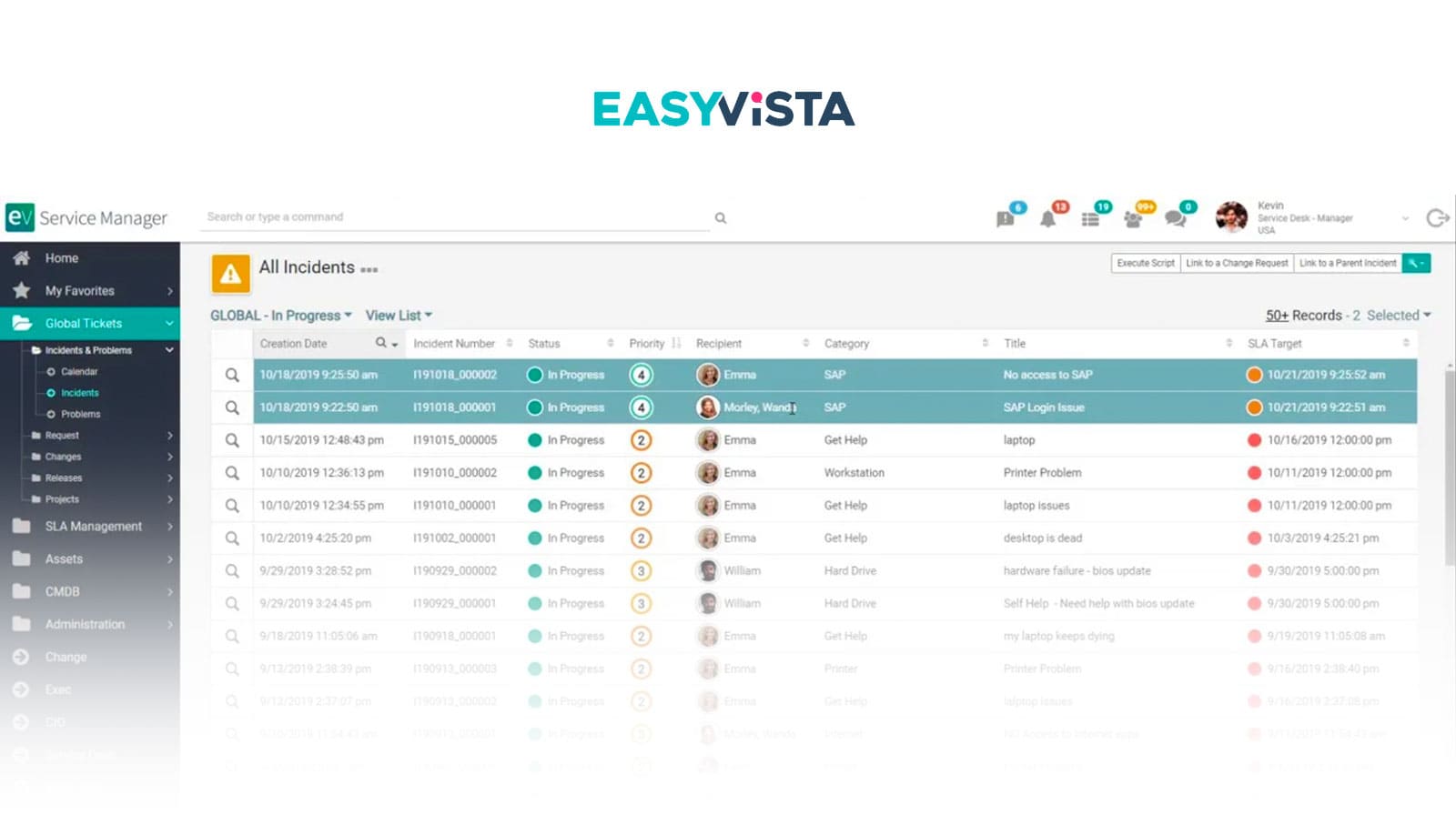
EasyVista is a cloud-based tool that simplifies and improves IT Service Management processes. It incorporates 11 ITIL PinkVerified procedures, promoting organizational efficiency and standardization.
Previously known as Staff & Line Group, EasyVista is a privately owned company that has been a prominent player in the ITSM industry since its inception in 1988. Its inclusion in the 2022 Gartner Magic Quadrant™ for ITSM Tools underscores its importance and position in the ITSM field.
What users like from EasyVista
EasyVista has received positive user reviews from industry sources like Gartner. To gain a deeper understanding of the platform's capabilities, let's explore some of the key strengths emphasized in these evaluations.
- ITSM features - EasyVista provides comprehensive IT Service Management features, including robust service catalog management. Users particularly appreciate the platform's high level of flexibility, especially in automating business actions. It excels in facilitating centralization, traceability, and visibility of actions, ultimately enhancing overall ITSM capabilities.
- User-friendly interface - EasyVista has a user-friendly interface that caters to a wide audience, including customers, IT personnel, and administrators. Its incorporation of all ITIL modules adds further value to the platform. Users have observed that EasyVista promotes smoother service processing and elevates service quality, making it a solution focused on user satisfaction.
- Configuration and customization - EasyVista simplifies the customization process through codeless configuration. Users have found that the platform's provision of groups, roles, and domains streamlines ticket assignment, improving efficiency. Regular updates based on customer feedback ensure that the platform remains current and adaptable to evolving needs.
- Efficiency - EasyVista is renowned for its capacity to enhance work efficiency. It offers support services for agility and consistently delivers high-quality results. These efficiency-focused features contribute to overall productivity and performance improvements.
- Workflow editor - One standout feature of EasyVista is its workflow editor, which translates documented processes into practical steps. Users appreciate its low-code options and extensive customization capabilities, making it a versatile tool for tailoring workflows to specific requirements.
What users don’t like from EasyVista
While EasyVista possesses several strengths and positive qualities, it's important to acknowledge that user concerns and criticisms have arisen in relation to specific aspects of the platform. These observations are based on reviews conducted by sources like Gartner. Here are some of the issues that have garnered attention:
- Complexity - Users have discovered that fully leveraging EasyVista's features demands a strong understanding of the platform, which can be a barrier for some users. The application builder is perceived as not very user-friendly, particularly for administrators who may find it challenging to navigate and utilize effectively.
- Functionality and customization - Users have mentioned that it takes time to fully configure all functionalities to meet expectations in EasyVista. They have expressed frustration with the limited customization options for screen elements, which restricts their ability to tailor the platform to specific requirements. Additionally, slowness has been reported as an issue, particularly when dealing with a large number of users.
- Usability and interface - Some users have indicated that EasyVista requires excessive clicks to perform common actions, resulting in time-consuming processes. The platform has faced criticism for its lack of intuitiveness, making it difficult to locate certain features. Users have observed that the out-of-the-box back office is complex and often requires customization to streamline the interface.
- Integration and modern technologies - EasyVista has faced criticism for lacking modern technologies and not meeting expectations regarding its SaaS version and integration capabilities with other tools. Users often seek more advanced integration choices and a smoother experience when working with external tools.
- Support and documentation - Users have raised concerns about inconsistent vendor support as a notable drawback. They have also pointed out that vendor documentation is both lacking and outdated, which can hinder the effective utilization of the platform. Furthermore, the application of updates often proves challenging due to insufficient vendor quality assurance and quality control (QA/QC) processes.
What’s EasyVista’s argument over Jira Service Management?
When compared to Jira Service Management, EasyVista makes a compelling case by leveraging several key strengths and attributes that set it apart as the preferred choice for organizations seeking a robust IT Service Management solution.
- ITSM features - EasyVista has an extensive array of IT Service Management features. Users applaud the platform's exceptional flexibility, particularly in automating business actions. It excels in promoting centralization, traceability, and visibility of actions, ultimately enhancing overall ITSM capabilities.
- User-friendly interface - EasyVista offers a user-friendly interface that caters to a broad audience. Its integration of all ITIL modules further elevates its value. Users have reported that EasyVista promotes smoother service processing and elevates service quality, underscoring its commitment to user satisfaction.
- Configuration and customization - EasyVista simplifies the customization process through its codeless configuration. Users have found that the platform's provision of groups, roles, and domains streamlines ticket assignment, enhancing operational efficiency. Regular updates based on customer feedback ensure that the platform remains current and adaptable to evolving needs.
- Efficiency - EasyVista is renowned for its ability to enhance work efficiency. It offers support services for agility and consistently delivers high-quality results. These efficiency-focused features contribute to overall productivity and performance improvements, aligning with the evolving demands of modern organizations.
- Workflow editor - A standout feature of EasyVista is its workflow editor, which effectively translates documented processes into practical steps. Users appreciate the availability of low-code options and extensive customization capabilities, making it a versatile tool for tailoring workflows to specific requirements.
What is Jira Service Management?
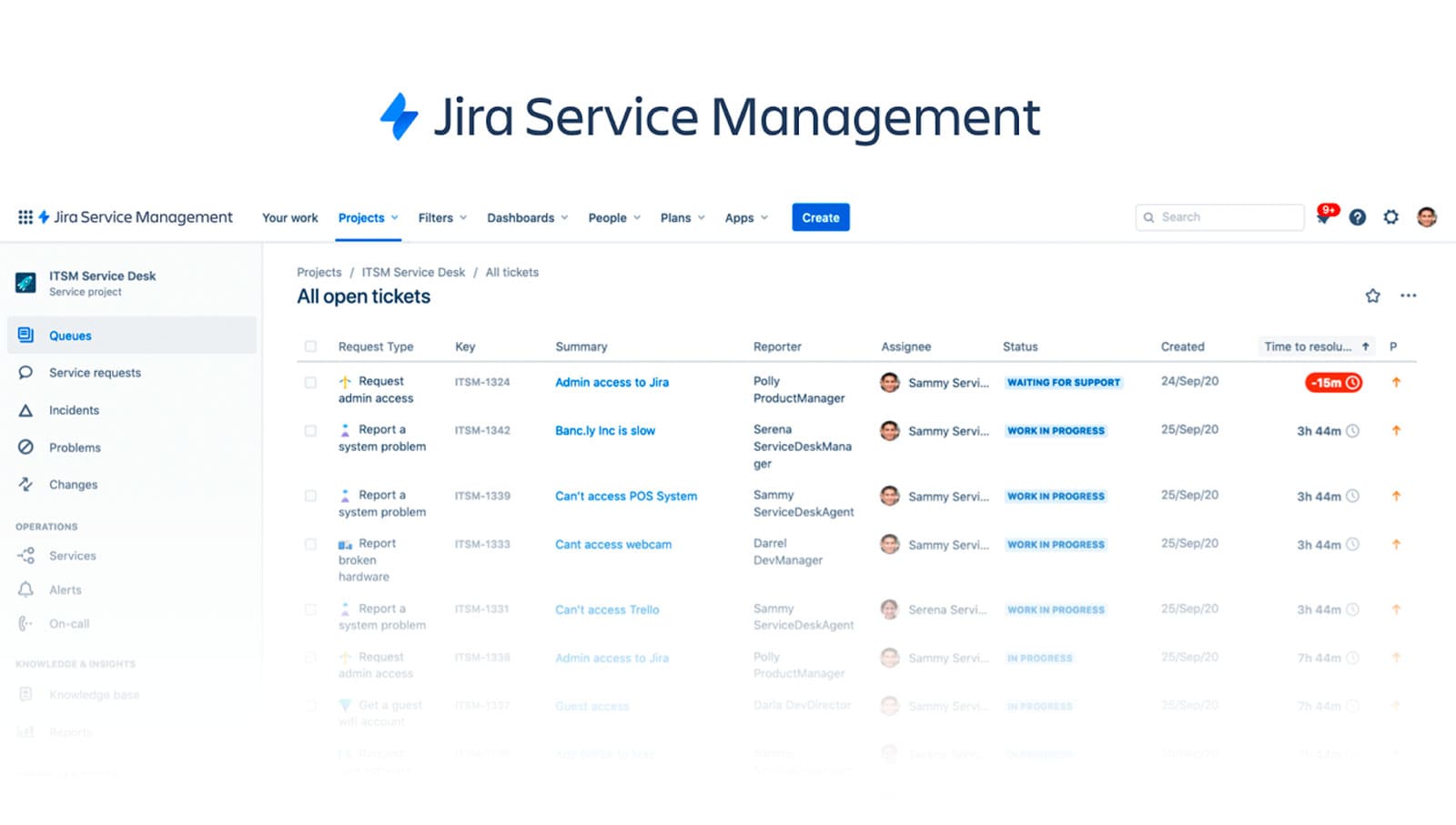
Jira Service Management, developed by Atlassian, stands out as an IT Service Management platform renowned for its user-friendly interface and robust capabilities, which empower businesses to improve service delivery and enhance customer satisfaction. Presently, Jira Service Management is available as a cloud-based solution, enabling organizations to harness the benefits of cloud computing for their Service Management needs.
Atlassian, the company behind Jira, was founded in 2002 by Mike Cannon-Brookes and Scott Farquhar in Sydney, Australia. Over the years, the company has undergone substantial growth and expanded its global presence by establishing offices in multiple countries.
Atlassian specializes in crafting software and tools designed to cater to the requirements of developers and project managers. Their product portfolio includes Confluence, Bitbucket, and Trello, among others. These tools address a wide spectrum of needs, spanning project management, issue tracking, collaborative content creation, code management, and team coordination.
What users like from Jira Service Management
User reviews from sources such as Gartner and G2 have highlighted the positive responses from users of Jira Service Management. Here are some notable benefits that have been recognized.
- Improved user portal for self-Service - Jira Service Management's platform boasts an enhanced user portal that elevates the self-service experience. This portal empowers users to independently assess and address incidents and requests whenever feasible. Furthermore, it allows users to provide post-resolution feedback, contributing valuable insights for ongoing enhancements and bolstering customer satisfaction initiatives.
- Efficient ticketing system with customizable workflows - The ticketing system, coupled with customizable workflows, simplifies task management. Teams can readily track and prioritize tickets according to their specific requirements.
- Intuitive and user-friendly interface - Users highly appreciate the platform's interface, renowned for enhancing incident and request management. Its design fosters ease of use, facilitating effortless interaction and navigation for teams.
- Comprehensive task details and robust filtering capabilities - Users value the wealth of task details that offer comprehensive insights into each task. This feature equips teams with a holistic understanding of their work. Additionally, the platform boasts robust filtering capabilities, empowering users to search, sort, and organize tasks based on specific criteria, ultimately enhancing productivity.
- Streamlined sprint planning and task assignment - Jira Service Management seamlessly integrates with popular collaboration platforms like Slack and Teams, streamlining sprint planning and task assignment processes. The Kanban view serves as a centralized hub for managing tasks, while the tagging feature facilitates the efficient organization of project-specific tasks.
- Flexible pricing options - Jira Service Management presents a spectrum of flexible pricing choices suitable for organizations of varying sizes and financial constraints. This includes a free plan tailored for small teams consisting of up to three users with 2 GB of storage. The cloud-hosted option offers a reasonably priced foundational package.
What users don’t like from Jira Service Management
Despite its many strengths and positive attributes, Jira Service Management has not been immune to criticism and concerns from its users. Here are some of the recurring issues identified in evaluations from reputable sources such as Gartner and G2.
- Complex migration process - Users have expressed their frustrations regarding the intricate nature of migrating their projects to Jira Service Management. Some have encountered challenges that might necessitate a separate user subscription, thereby compounding the overall complexity associated with the migration procedure.
- Limited and complicated integrations - Users have voiced their desire for more straightforward integrations and have frequently resorted to developing customized solutions to establish connections between Jira Service Management and specific tools. The process of integrating the platform with external systems has proven to be both laborious and time-intensive.
- A steep learning curve - The platform's extensive array of capabilities and functionalities can present a formidable learning curve for users. This intricacy may mandate supplementary guidance or training to enable individuals to navigate the system effectively and leverage its features proficiently.
- Support issues with Atlassian - Users have reported challenges when seeking assistance from Atlassian support. Procuring the requisite support and guidance has proven to be an obstacle for certain individuals, potentially impacting their overall satisfaction with the platform.
- Shortcomings in task tracking and reporting - Users have encountered limitations when it comes to tracking tasks and generating reports, impeding their capacity to effectively monitor and analyze project progression and performance. These constraints encompass issues with tracking multiple tasks, crafting comprehensive reports, and tailoring dashboards within the platform.
- Reliance on supplementary plugins - Users have found it necessary to depend on additional plugins to access fundamental features within the system. Additionally, ensuring compliance with data protection regulations, such as GDPR, has presented challenges for certain users.
- Less intuitive interface - In contrast to alternative options, some users have found Jira Service Management's interface to be less user-friendly, particularly concerning external customers engaging with the platform.
What’s Jira Service Management’s argument over EasyVista?
Jira Service Management brings a host of unique strengths and capabilities to the table, distinguishing it from alternatives like EasyVista. Let's delve into what sets Jira Service Management apart.
- Enhanced self-service experience - Jira Service Management stands out with its improved user portal, designed to elevate the self-service experience. This portal empowers users to independently assess and address incidents and requests, fostering user autonomy. Additionally, it enables users to provide post-resolution feedback, a valuable feature that contributes essential insights for continuous enhancements and strengthens customer satisfaction initiatives.
- Efficient ticketing and customizable workflows - The platform's ticketing system, coupled with customizable workflows, simplifies task management. Teams benefit from a user-friendly interface that allows them to effortlessly track and prioritize tickets based on their unique requirements. This streamlined ticketing process enhances efficiency and ensures that critical tasks receive prompt attention.
- Intuitive interface for enhanced productivity - Users highly appreciate Jira Service Management's intuitive and user-friendly interface, renowned for its ability to enhance incident and request management. Its thoughtful design promotes ease of use, facilitating seamless interaction and navigation for teams. This intuitive interface significantly contributes to the platform's reputation for user satisfaction.
- In-depth task details and robust filtering - Jira Service Management excels in providing comprehensive task details that offer profound insights into each task. This feature equips teams with a holistic understanding of their work, enabling them to make informed decisions. Furthermore, the platform offers robust filtering capabilities, empowering users to search, sort, and organize tasks based on specific criteria. These capabilities significantly boost productivity by enabling efficient task management.
- Seamless integration and collaboration - The platform seamlessly integrates with popular collaboration platforms such as Slack and Teams, simplifying sprint planning and task assignment processes. Its Kanban view serves as a centralized hub for managing tasks, while the tagging feature facilitates the efficient organization of project-specific tasks. These integration capabilities promote streamlined collaboration, enhancing team efficiency.
- Flexible pricing choices - Jira Service Management understands the diverse needs and financial constraints of organizations. It offers a range of flexible pricing options suitable for varying company sizes.
Considering InvGate Service Management as an ITSM solution alternative

While EasyVista and Jira Service Management are well-known competitors in the IT Service Management industry, exploring alternative solutions that can better meet your organization's specific needs is essential. In this context, consider giving careful consideration to InvGate Service Management.
Let's examine the beneficial features of InvGate Service Management that make it a valuable choice for fulfilling your organization's ITSM requirements.
Exceptional user experience
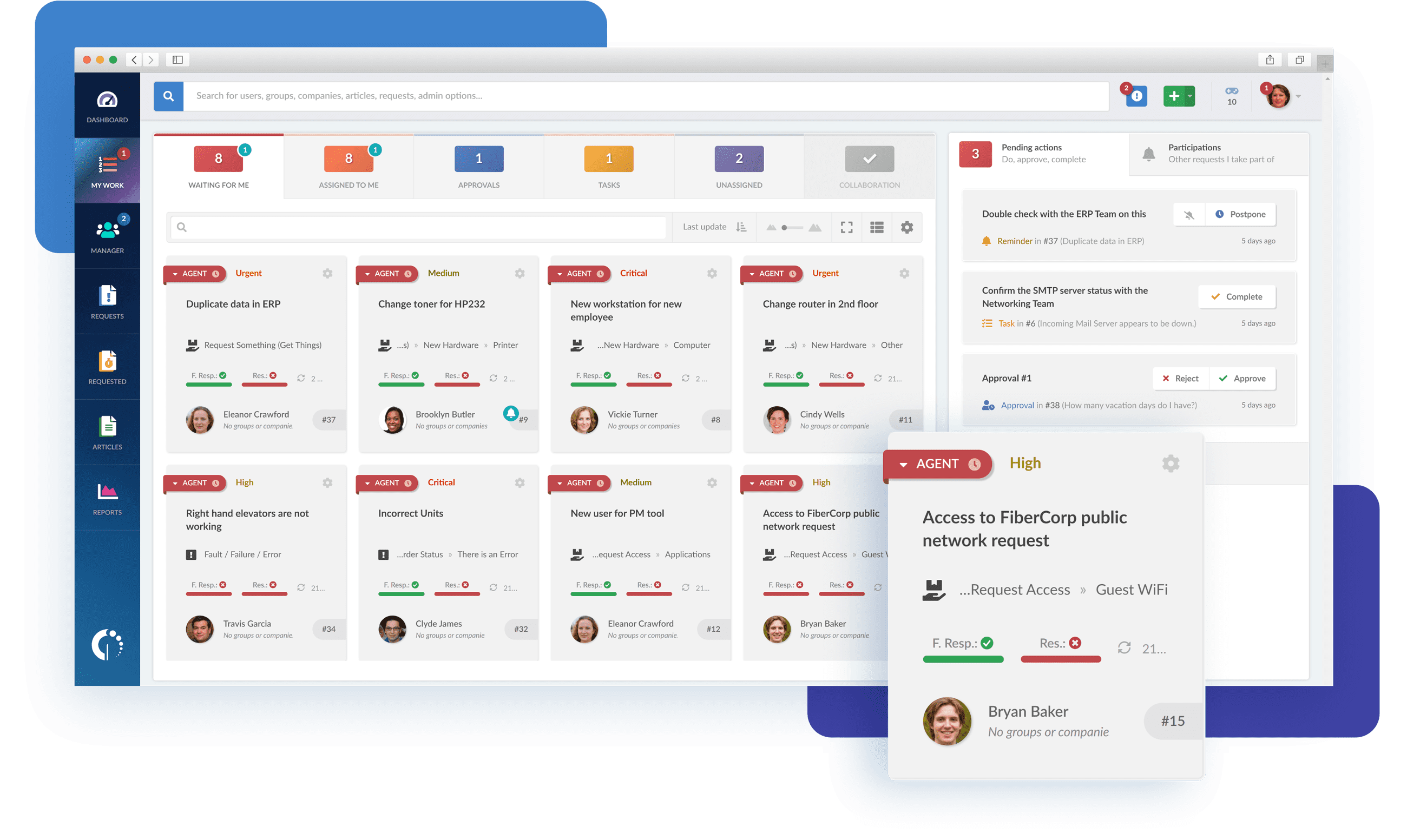
InvGate Service Management prioritizes delivering an outstanding user experience through careful design and adherence to UI/UX best practices. Its intuitive interface promotes rapid adoption, reducing the need for extensive training and enabling users to be productive.
Efficient Ticketing and Incident Management
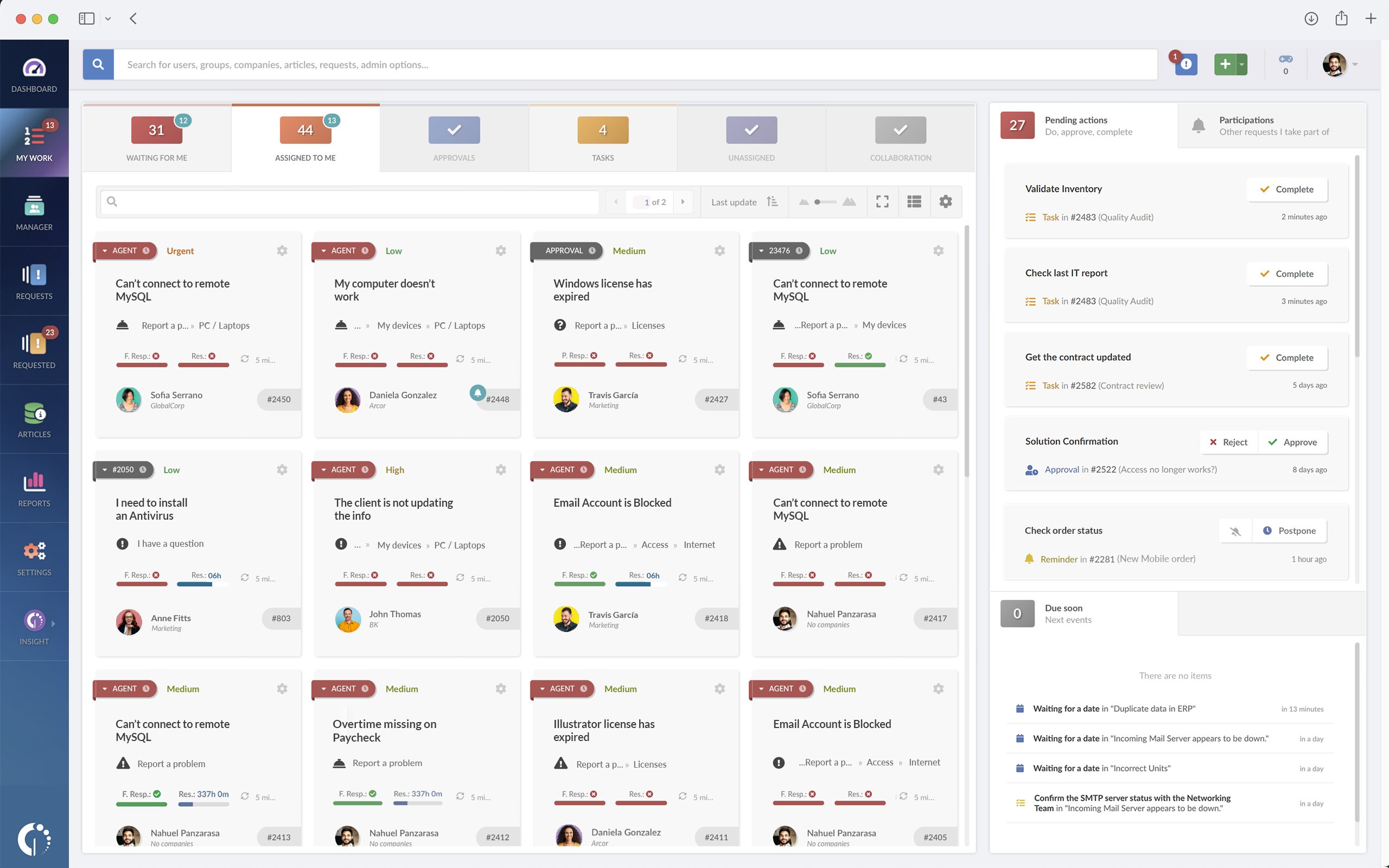
InvGate Service Management excels in providing robust capabilities for managing tickets and incidents. It empowers IT teams to efficiently track, collaborate on, and resolve incidents, enabling effective prioritization. Features such as automated ticket routing, customizable workflows, and SLA Management significantly enhance the efficiency of incident resolution processes.
ITIL4 certification
InvGate Service Management has obtained the prestigious ITIL4 certification from PINK Elephant, demonstrating its commitment to upholding ITSM excellence. Whether organizations are starting their ITIL journey or managing complex operations, InvGate Service Management provides a user-friendly and feature-rich experience aligned with industry best practices.
Customization and flexibility
InvGate Service Management provides flexible deployment options, offering organizations a choice between on-premise or cloud-based solutions. This flexibility ensures that the platform can adapt to the specific requirements of various sectors and industries.
Comprehensive Asset Management
When integrated with InvGate Asset Management, organizations gain a complete view of their IT ecosystem, leading to enhanced service delivery and reduced downtime. InvGate Asset Management offers various features, including IT Asset Discovery, Inventory Management, Software License Management, and maintenance schedules.
Streamlined configuration and setup
InvGate Service Management offers a simplified configuration and setup process, using a no-code/low-code approach. This approach allows both inexperienced and experienced users to implement the system without requiring extensive technical expertise. The platform expedites setup by providing straightforward configuration options, enabling organizations to quickly harness its robust ITSM capabilities.
Comprehensive reporting and analytics
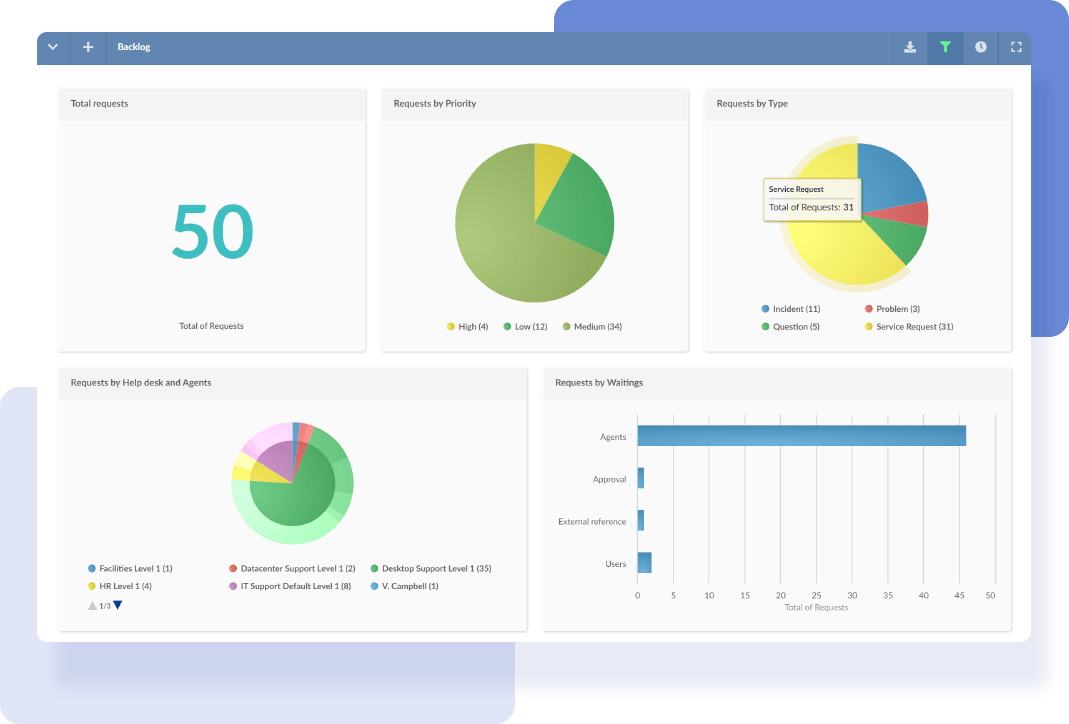
InvGate Service Management offers comprehensive reporting and analytics functionalities, enabling organizations to gain valuable insights into their IT operations and performance. The platform provides ready-to-use reports and customizable dashboards, allowing IT teams to analyze data, identify patterns, and make informed decisions to enhance their services.
Powerful self-service functions
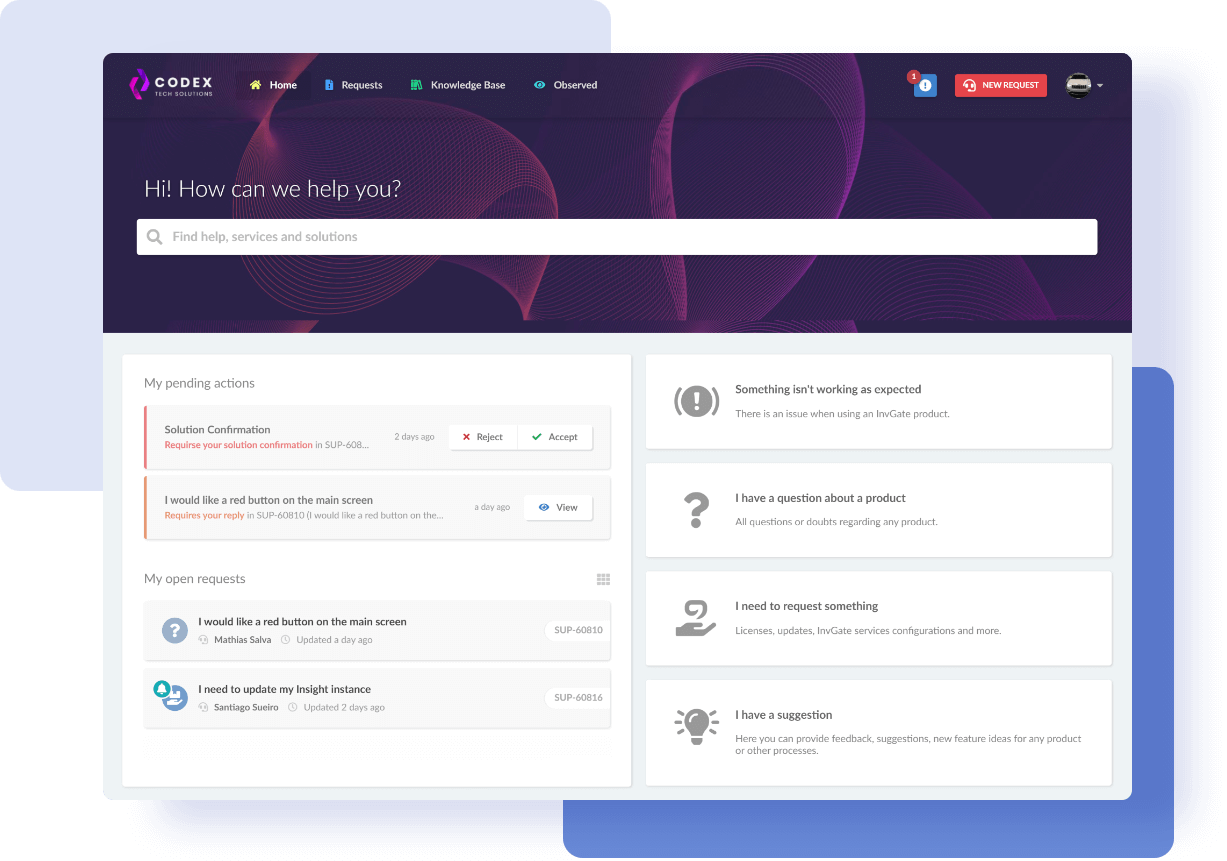
InvGate Service Management incorporates robust self-service functionalities, including a user-friendly portal, an extensive IT service catalog, and a knowledge base. These capabilities empower end-users to independently resolve common issues, access various IT services, and utilize self-help resources, reducing the workload on IT staff.
Cost-effective solution
InvGate Service Management delivers a cost-effective solution without compromising functionality. It offers a comprehensive range of ITSM features at a competitive price, making it an attractive choice for organizations seeking affordability without sacrificing capabilities. Compared to alternatives like EasyVista and Jira Service Management, InvGate Service Management strikes a balance between cost and functionality.
Fast ROI and continuous innovation
InvGate Service Management ensures a rapid return on investment through efficient implementation processes. Within weeks, organizations can begin realizing the benefits of this robust ITSM solution. Additionally, regular feature updates keep users at the forefront of technology without incurring additional costs.
ITSM excellence with ESM capabilities
InvGate Service Management is designed primarily for ITSM but seamlessly extends its capabilities to Enterprise Service Management (ESM). This empowers operational departments to improve their processes and fully embrace the advantages of digital transformation. With a strong focus on ITSM and high performance in ESM, InvGate Service Management facilitates streamlined workflows and comprehensive digital transformation initiatives across all departments.
Next steps
Choosing between EasyVista vs. Jira Service Management is a challenge for organizations looking for the ideal IT Service Management solution. Both platforms offer valuable features, and choosing the right one depends on your specific needs and goals.
However, as you navigate the landscape of ITSM solutions, it's essential to remain open to alternatives that could potentially revolutionize your IT services and drive digital transformation. One such alternative is InvGate Service Management. This dynamic ITSM platform excels in delivering streamlined functionalities and robust features designed to enhance IT services and future-proof your organization's ITSM strategy.
Download our free ITSM implementation checklist to help you map your next steps and ensure a seamless transition to your chosen ITSM solution.
















